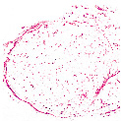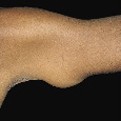Angiolipomas
General Information
Angiolipoma is a slow growing, benign tumor containing vascular (blood vessels) and mature adipose (fat cells) elements. Multiple angiolipomas usually appear, the first appearing just after puberty. This benign tumor is commonly found on the trunk, neck or in the extremities. Angiolipomas are categorized into two subtypes: non-infiltrating and infiltrating, with non-infiltrating being the more common of the two. Non-infiltrating angiolipomas are mainly seen in young adults and presents as painful, soft, subcutaneous nodules. Infiltrating angiolipomas are rare, usually involving the extremities and may extensively infiltrate into the surrounding tissues, such as bones, muscles, nerves, and fibrocollagenous tissues. Healthcare providers’ choice of treatment for non-infiltrating angiolipomas is total surgical removal. Treatment for infiltrating angiolipomas is a total resection of the tumor for relief of symptoms.
Epidemiology
Occurs in young adults
Etiology
Unknown
Pathogenesis
Slow growing and does not undergo malignant transformation
Clinical
Presents as multiple, painful yellow, firm, circumscribed tumors from 1 to 4 cm in diameter
Histology
Thin fibrous capsule with incomplete fibrous septa dividing the lesion into lobules of different sizes
Bibliography
1. “Angiolipomas” (Online) July 2006. http://www.doctorndtv.com/faq/detailfaq.asp?id=9312 (visited: March 14, 2008) 2. Weeden, David AO, MD, FRCPA Skin Pathology, Second Edition Churchill Livingstone 2002.
Download PDF
![]() Angiolipoma
Angiolipoma


